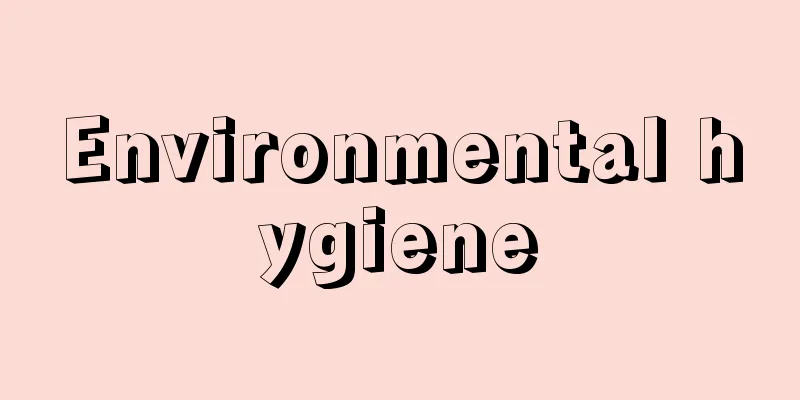Environmental hygiene

|
It refers to addressing health and disease issues from the perspective of the environment surrounding humans, and aiming to maintain and promote health by improving the relationship between humans and the environment. Environmental factors that affect human health can be divided into the biological environment, such as microorganisms and parasites; the physical environment, such as heat, cold, air pressure, radiation, and noise; and the chemical environment, such as gas, dust, and chemicals. The influence of the environment on health has been of interest since ancient times, as described by the ancient Greek Hippocrates in his treatise "Air, Water, and Place." In 1700, Italian scholar B. Ramazzini (1633-1714) wrote "Diseases of Working People," in which he described in detail the workplace environment and illnesses. In 19th century England, E. Chadwick (1800-1890) believed that ill health caused by poverty could be improved by sanitizing the environment, and launched a sanitary reform movement. This movement is said to be the beginning of public health. In Germany in the late 19th century, Pettenkofer pointed out that the outbreak of infectious diseases, which were rampant at the time, was caused not only by specific viruses and individual predispositions, but also by environmental conditions such as the season and the land, and conducted pioneering research on architectural sanitation, such as air heating and ventilation in homes, and environmental sanitation, such as water and sewage systems. In Western countries, environmental sanitation measures such as water supply and sewerage systems and the cleaning and treatment of waste from urban life progressed rapidly with the advancement of sanitary engineering in the 20th century, but in Japan, there was a significant delay, and it was not until the 1950s that they finally reached the stage of full-scale dissemination. Meanwhile, with the rapid industrial development after World War II, in Japan too, waste generated by industrial production activities polluted the air, water, soil and other parts of the environment, causing health problems for people living in the general local community, and these measures came to play an important role in environmental sanitation. The main national programs currently being implemented to promote environmental sanitation in Japan include the treatment of water supply and sewerage, human waste, garbage, industrial waste, etc., as well as food sanitation to prevent food poisoning and food additives, sanitation of places where large numbers of people gather such as hotels, entertainment venues, public baths, and swimming pools, sanitation measures for large buildings, safety to prevent the dangers of containing harmful chemicals, and prevention of pollution. Of these, prevention and measures against damage to health and the living environment caused by air, water, and soil pollution, noise, vibration, land subsidence, foul odors, etc. are the responsibility of the Ministry of the Environment, while other environmental sanitation measures are the responsibility of the Ministry of Health, Labor and Welfare. [Sadayoshi Shigeta] [Reference item] |Source: Shogakukan Encyclopedia Nipponica About Encyclopedia Nipponica Information | Legend |
|
健康や疾病の問題を、人間を取り巻く環境の側から取り上げて、人間と環境の相互関係を改善することによって、健康の維持、増進を図ることをいう。 人間の健康にかかわりのある環境要因としては、微生物、寄生虫などの生物的環境、暑さ・寒さ、気圧、放射線、騒音などの物理的環境、ガス、粉塵(ふんじん)、化学薬品などの化学的環境などに分けることができよう。 環境が健康に及ぼす影響については、古代ギリシアのヒポクラテスが『空気・水・場所』という論文のなかで述べているように、古くから関心をもたれている。1700年にはイタリアの学者ラマッツィーニB. Ramazzini(1633―1714)が『働く人々の病気』を著し、職場の環境と疾病について詳細な記述を行っている。19世紀のイギリスではチャドウィックE. Chadwick(1800―90)が、貧困によってもたらされる不健康は、環境の衛生化によって改善できると考え、環境改善運動sanitary reformを展開した。この運動が公衆衛生の発端であるといわれる。19世紀後半のドイツでは、ペッテンコーファーが、当時流行の激しかった伝染病の発生は、特定の病毒や個人の素因のほかに、時季、土地などの環境条件なども関与していることを指摘して、空気暖房、住居の換気などの建築衛生、さらに上下水道などの環境衛生に関する先駆的な研究を行っている。 欧米諸国では、上下水道や都市生活に伴う廃棄物の清掃処理などの環境衛生対策は、20世紀に入って衛生工学の進歩とともに急速に進んだが、日本の場合はその遅れが著しく、昭和30年代に入って、ようやく本格的な普及の段階に入った。一方、第二次世界大戦後の急速な産業の発展とともに、日本でも工業生産活動によって排出される廃棄物が大気、水、土壌などの環境を汚染し、それによって一般地域社会に住む人々にも健康障害がみられるようになり、この対策が、環境衛生において重要な部分を占めるようになった。 現在、わが国で環境衛生を推進するためにとられている国レベルでのおもなプログラムは、上下水道、屎尿(しにょう)、ごみ、産業廃棄物などの処理のほか、食中毒、食品添加物などの食品衛生、旅館、興行場、公衆浴場、プールなど多人数が集まる場所の衛生、大型建築物の衛生対策、有害化学物質含有の危険防止のための安全、公害の防止などとなっている。このうち、大気・水質・土壌の汚染、騒音、振動、地盤の沈下、悪臭などによる健康および生活環境被害についての防止や対策は環境省の所管となっており、そのほかの環境衛生対策は厚生労働省の所管となっている。 [重田定義] [参照項目] |出典 小学館 日本大百科全書(ニッポニカ)日本大百科全書(ニッポニカ)について 情報 | 凡例 |
Recommend
Eugène Carrière
French painter. Born in Gourenay. In 1870 he move...
Outline of Civilization Theory - Bunmei-ron no no gairiyaku
This was the first Japanese treatise on civilizat...
Messenger of God
〘Noun〙 (also "jinshi") A messenger of th...
Principia - Principia (English spelling)
A physics book. A book formulating the general la...
Hiroshi Ikeda
1881-1939 A bureaucrat from the Taisho to early S...
Hadriana
… During the conquest of the East by Emperor Traj...
Rosetta
...Population 37,000 (1966). Also known as Rosett...
Taifang County
A Chinese district in ancient Korea. Lelang Distr...
Miyoshi clan
A clan of military commanders based in Miyoshi Co...
infrared mark
...This means that the distance between the lens ...
High-speed car
A Turkic northern nomadic tribe that appeared in ...
Kyobashi - Kyobashi
[1] A bridge over the Kyobashi River in Chuo Ward,...
piece bien faite (English)
…In French, pièce bien faite literally means a we...
Vallisneria denseserrulata (English spelling)
… [Takashi Yamashita]. … *Some of the terminology...
Jimokuji [town] - Jimokuji
A former town in Ama County, western Aichi Prefect...

![Tsuruta [town] - Tsuruta](/upload/images/67cc3e547b97b.webp)







